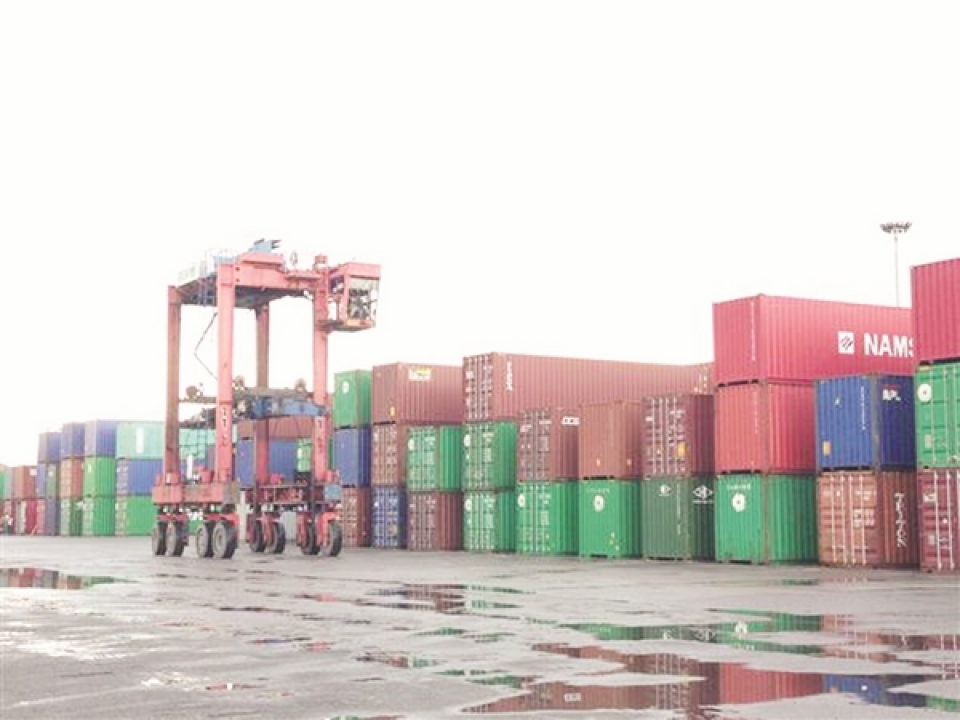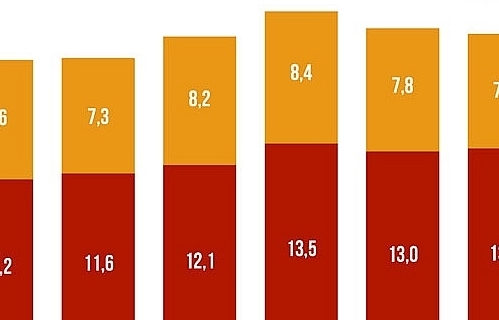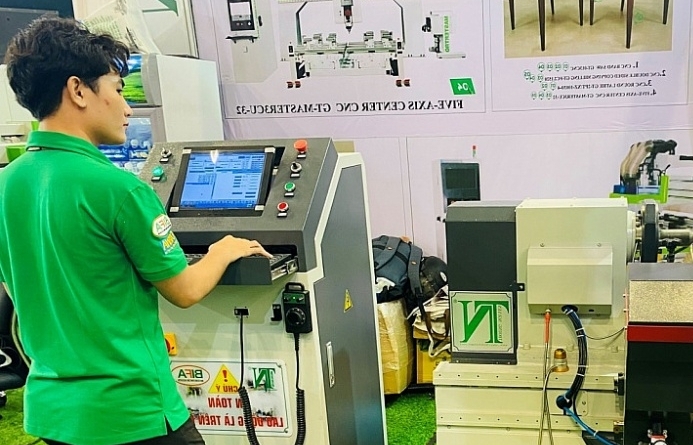How will Vietnam's economy change with CPTPP?
 |
| Under the CPTPP agreement, Vietnam's export of goods will have certain advantages. Photo: La Dịu. |
GDP increased by 1.32%
According to the Multilateral Policy Department (Ministry of Industry and Trade): The CPTPP is a meaningful gathering of countries in the region, capable of bringing about practical benefits and advantages, thereby enabling countries to consider to participate in CPTPP, promote the trend of cooperation in the Asia-Pacific region.
In terms of economy, joining the CPTPP is beneficial for Vietnam. The agreement will contribute to boosting the export of goods to major markets such as Japan, Australia, Canada and Mexico, as well as attracting foreign investment in the fields that Vietnam is in need of development. Another important part of the CPTPP is to help Vietnam reform domestic institutions, create a transparent and open investment and business environment. Multilateral Policy Department evaluates this as a long-term benefit. In addition, the CPTTP Agreement is open. When other countries join the Agreement, the benefits to Vietnam will also increase. As a participant from the start, Vietnam will have an advantage in protecting its interests.
Recognizing the economic benefits of the CPTPP Agreement in a more quantitative perspective, discussing with the reporter of Customs Newspaper, Mr. Tran Toan Thang, Head of the World Economic Committee, National Center for Economic Information and Forecast (NCIF), Ministry of Planning and Investment said: In general, the overall CPTPP Agreement is beneficial to Vietnam, but much lower than the Trans-Pacific Partnership Agreement (TPP). Specifically, due to the impact of tariff reductions, the CPTPP Agreement could increase GDP by 1.32%, to 1.7 billion USD (in TPP, about 6.7%). This impact could be greater if Viet Nam implemented concurrent tariff reductions and service liberalization under the service opening scenario (2.01%).
Exports increased by 4%
According to Mr. Toan Thang Thang, Vietnam is expected to gain export benefits by 4% (4.09 billion USD). Total imports will also increase by 3.8-4.6% (equivalent to 4.93 billion USD). Due to higher export growth rates, the risk of trade deficit may be curbed over time. The increase in exports was mainly to CPTPP countries. This shows that joining CPTPP can help Vietnam diversify its export market. For imports, the level of increase by the CPTPP from the countries in the block is not large. The increase in import will be mainly from non-CPTPP countries. According to this result, Vietnam will continue to depend on imports from some countries such as China, Korea even with CPTPP.
"In general, the positive impact on the economy of the CPTPP agreement compared to the Vietnam FTA has been negotiated, but the signs are not by much. However, taking into account all factors, in the end, participation will benefit. If the CPTPP countries join hands with one another, trade relations will be less likely to result in trade relations with countries outside the BTA. The above figures are only relative, as factors such as institutional impact, business environment, productivity fluctuations etc., are not included in the calculation. Actual figures may be higher but may be lower than predicted," Mr. Thang said.
The challenge of institutional reform
According to some experts, in addition to the close benefits from the CPTPP, Vietnam will also face many challenges. Typically, the production structure is difficult to change quickly. Currently, Vietnam mainly imports raw materials and old technology to produce, then export. Emerging markets are China, Korea. This makes it difficult for Vietnam to benefit from tax rates as the contents of the CPTPP clearly regulate the rules of origin of products. Accordingly, in order to enjoy preferential tax rates, products must originate from the countries participating in CPTPP. To change the structure of this export requires a certain period of time as well as technological strategy. At present, the majority of businesses still look at short-term, not long-term investment for technology change. The state needs to create a better environment for businesses to have long-term expectations, to focus more on technology to change production.
With regard to this issue, Associate Professor Hoang Van Cuong, Vice Rector of the National Economics University, said that the emerging problem of Vietnam with the CPTPP Agreement is the ability to adapt poorly to the standards set out. This is reflected in factors such as Vietnam has backward technology, market control, production organization etc., also has not caught up with other countries.
Some experts have suggested that although promoting domestic institutional reform, creating favorable business and investment environment is considered as a long-term benefit for Vietnam when joining the CPTPP, in the immediate future, this is not a small challenge. Like the TPP Agreement, the CPTPP still puts pressure on vigorous institutional reforms on Vietnam, when direct provisions require Viet Nam to change its rules and regulations.
Obviously, in the story of institutional reform, improve the investment environment, business, the past time, and many business conditions as well as the license has been carried out with continuous cuts. Administrative procedures are also significantly simplified, but it seems that all these are not enough to create a push for business. The story here is not a measure of the number of permits or business conditions cut, but the key is to hit the operational element, the human factor for real institutional change, not just stop in the form of simple cuts.
From a corporate perspective, Mr. Tran Van Linh, Chairman of the Board of Directors of Thuan Phuoc Seafood and Trading Joint Stock Company (Da Nang) expressed the view that the most important thing when joining the CPTPP is that Vietnam will develop faster to become a full market economy. Meanwhile, Vietnamese enterprises will be free from trade impediments imposed by other countries because Vietnam is not recognized as a market economy. With the fishery sector in particular, businesses do not expect the FTA to reduce tariffs because the current tariff lines are very low, even 0%. The biggest desire of enterprises is the real institutional change to meet the requirements of integration.
Related News

“Give and Take” in the Value Chain of the CPTPP Market
09:30 | 20/12/2024 Import-Export

Ho Chi Minh City achieves record state revenue of over VND500 trillion in 2024
10:33 | 10/12/2024 Finance

Multiple drivers propel positive growth in budget revenue
10:33 | 05/12/2024 Finance

Revising policies to adapt to two-way impact of FTAs
09:24 | 10/11/2024 Finance
Latest News

Top 10 Reputable Animal Feed Companies in 2024: Efforts to survive the challenges of nature
18:30 | 21/12/2024 Import-Export

Vietnam's import-export surges 15.3%
09:44 | 20/12/2024 Import-Export

More Vietnamese firms interested in Saudi Arabia: Ambassador
09:43 | 20/12/2024 Import-Export

Binh Dinh province works to attract investment from Japan
15:44 | 19/12/2024 Import-Export
More News

Agricultural, forestry and fishery exports “reach the target” early
15:20 | 19/12/2024 Import-Export

Thailand remains Vietnam’s biggest trading partner in ASEAN
15:35 | 18/12/2024 Import-Export

Rubber value soars in 2024: VRA
15:33 | 18/12/2024 Import-Export

Vietnamese businesses struggle to access green finance
09:58 | 18/12/2024 Import-Export

E-commerce: a gateway to boost Vietnamese commodities in the UK market
16:55 | 17/12/2024 Import-Export

Agro-forestry-fisheries exports top 62 billion USD in 2024
16:51 | 17/12/2024 Import-Export

Removing “bottlenecks” for digital transformation in industrial production
10:00 | 17/12/2024 Import-Export

UKVFTA facilitates Việt Nam's tuna exports to UK market
13:56 | 16/12/2024 Import-Export

Vietnam’s garment-textile exports expected to reach 44 billion USD this year
13:53 | 16/12/2024 Import-Export
Your care

Top 10 Reputable Animal Feed Companies in 2024: Efforts to survive the challenges of nature
18:30 | 21/12/2024 Import-Export

Vietnam's import-export surges 15.3%
09:44 | 20/12/2024 Import-Export

More Vietnamese firms interested in Saudi Arabia: Ambassador
09:43 | 20/12/2024 Import-Export

“Give and Take” in the Value Chain of the CPTPP Market
09:30 | 20/12/2024 Import-Export

Binh Dinh province works to attract investment from Japan
15:44 | 19/12/2024 Import-Export




